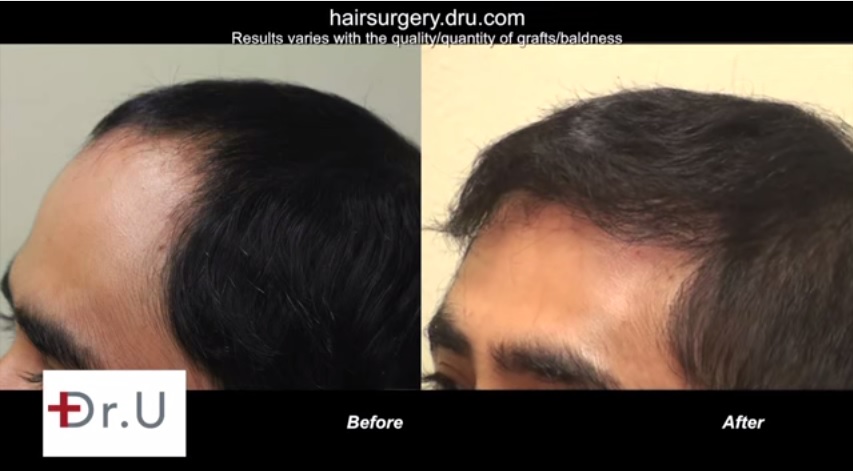WHY DO MOST HAIR RESTORATION CLINICS NOT PERFORM TEMPLE POINT HAIR RESTORATION:
Many patients have offered Dr U their previous Drs reason for not dealing restoring temple points or temple hair restoration tha range from “hair does not grow in this area” to “it is not done” . Most likely reasons are:
- Reliance head donor pool only: A transplant that only considers the donor lifetime supply from the back and sides of the head which is limited to 5000-7000 grafts in most, it makes sense to prioritize areas of coverage and in that calculaton, the temple points and crown are relegated to the back. Since Dr U can expand this donor pool substantially by using the UGraft Advanced FUE and using body and beard donors, this is less a restricting factor.
- Lack of the finest caliber hairs required to craft a natural looking softer result. The finest hairs are found in the nape and peri-auricular areas as well as various parts of the body such as the legs and arms. Read about Dr U’s ue of nape and peri-auricular hair in the crafting of undetectable hairlines and temples
- Lack of skills. because of the intricate nature of angle conversion from the sides to the frontal hairline transition, a great deal of skill and experience is required in reconstructing the temples and temple points. Dr U has observed that most of the patients coming to see hi with pror attempts at temple hair transplant at other clinics have been poorly executed and often require repairing.
Hair restoration is a refined dance that demands the practitioner possess artistic vision as well as superior medical skill. To the casual observer, a full head of hair is nothing more. But in reality, it is made up of a distinct crown whorl, hairline texture and positioning, and temple point angulation and shape. For the millions of hair loss sufferers who select hair transplant for a permanent solution, their cosmetic fate rests in the surgeon’s steadfast and capable hands; and whether he/she possesses or lacks the ability to rebuild these complex pieces into a natural-looking head of hair. The temple area is possibly one of the most intricate parts of all, and also very important since they help frame the face.
HAIR LOSS
Temple hair loss is unique to two types of baldness:
- Androgenic alopecia
- Traction alopecia
Androgenic alopecia is more widely known as pattern baldness. In the case of temple loss, the condition is specific to men. Pattern baldness is an incurable genetic ailment that gets passed through generations of family by weak androgen receptors in the X chromosomes. This hereditary weakness allows scalp follicles to be ravished by the hormone DHT, which shrinks the hairs until they break off or virtually disappear. The condition is most recognizable in men as crown hair loss and a receding hairline.
Male pattern baldness causes 95% of male balding and is much more rampant than traction alopecia; although traction alopecia still commonly affects African American women.
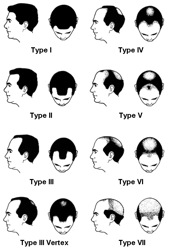
TEMPLE HAIR RESTORATION: SPECIFICATIONS
The temples are one of the defining elements of hairline creation. Without naturally placed temple hair, the entire hairline falls short. In fact, this conundrum creates a common obstacle for the novice surgeon, as the temple grafts must change angle and direction as they flow along the sides of the face. The temple points protrude toward each eyebrow in a pointed shape. Just above them are the temporal recesses and just below them are the sideburns.
For a surgeon to successfully recreate the temple points, he or she must take into account:
- Texture/Density
- Graft placement
- Shape
Texture/Density
Falling along the hairline, the temple points are best served if created with the softest, finest caliber of donor hair. This helps to achieve an overall gradual and natural hairline design, which many hair transplant results lack. With the individual excision method practiced in follicular unit extraction, the surgeon can execute a temple hair restoration using hair from the nape of the neck or the legs instead of the traditional zone (the rear middle scalp). These non-traditional hairs are the ideal texture to create the most aesthetically pleasing outcome.
The surgeon must also decide how closely packed he wants the grafts to be, which will determine the density. The density of the temple points should flow seamlessly with that of the hairline.
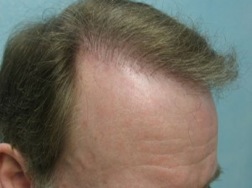
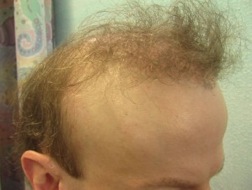
Graft Placement
This takes angle and direction into account. Since the temple hair does not point in the same direction nor have the same angulation as the hair surrounding it, the surgeon must place each graft carefully. The angle and direction of every hair must transition flawlessly from hairline to temporal recesses, to temple points, to sideburns.
Shape
The shape must be designed to complement the facial-skeletal contours of each unique temple hair restoration, as well as the patient’s age. Some temple points have a sharp peak while others are softer and more rounded. These differences in shape give balance to the other features while affecting the appearance of a youthful, aggressive hairline versus a mature hairline.
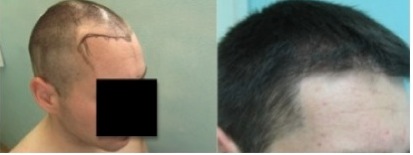
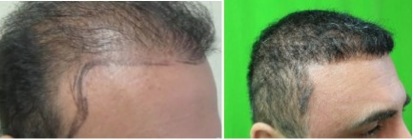
PHOTOS AND VIDEOS
Photos and videos of past results give future patients a good idea of what to expect based on the technique and surgeon used. It is important for those researching hair transplant to review several images before making any decisions. Viewers should scrutinize how well the temple hair flows with surrounding hair based on the considerations mentioned above. Good quality photos and videos will always be in focus, taken in good light, and never retouched or edited.
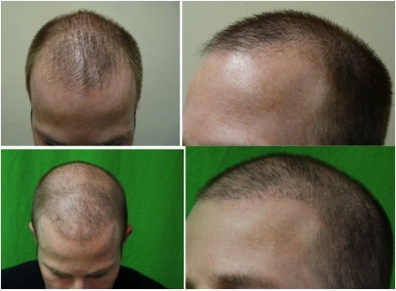
FAQ
Is FUE the best method for temple hair restoration?
There is no other method like FollicularUnit Extraction FUE. Based on its minimally invasive excision technique, FUE makes it possible to select donor hair with the best cosmetically satisfying outcome in mind. So, for the most natural-looking results, FUE is the best method.
How important is it to find a good surgeon?
Finding a good surgeon is the most important decision you can make. Think of the surgeon as a painter. The painter chooses the brush, the colors, and the picture, and makes every stroke to execute his/her painting. While acrylic paint or oil paint may alter the outcome, nothing influences the results as much as the painter.

